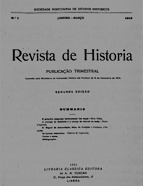

................................
The public positions held by certain members are also worthy of note since they highlight the ideological diversity converging within the SPEH. An analysis indicates that at least 20 members held one or more public offices , encompassing a wide range of roles. Examples include mayors, such as Anselmo Braamcamp Freire (Lisbon), who also served as a member of the Republican Constituent Assembly, and António Mendes Correia, the Mayor of Porto; civil governors, such as Cristóvão M. Sepúlveda (Bragança) and Henrique da Gama Barros (Lisbon); and ministers, including Ginestal Machado (Education) and Aurélio da Costa Ferreira (Development and Labour). These characteristics are examined in greater detail in A SPEH no contexto historiográfico nacional , pp. 59-62.
The first issue of the Revista de História (RH) was published a year after the SPEH's foundation, with quarterly editions later compiled into 16 annual volumes. As outlined in its statute (Art. 2), the journal was part of the initiatives undertaken by the SPEH. It featured contributions not only from members but also from external collaborators, thus expressing work by various authors, some of whom were relatively unknown in the cultural context of the time—a goal of the journal. From its inception, the RH held a prominent position among national scientific periodicals, particularly those dedicated to history, such as the Arqueólogo Português [Portuguese Archaeologist] (1890–1921) and the Arquivo Histórico Português [Portuguese Historical Archive] (1903–1921). In fact, the RH initially presented a more modern structure compared to its contemporaries. Proposals were even made to include abstracts, summaries in a foreign language, most likely French, to increase the visibility of Portuguese research in Europe, though this was never achieved . Nonetheless, the RH established exchange agreements with both national and international institutions, including foreign universities, largely owing to the social network cultivated by Fidelino during this decade of the twentieth century .
This work is financed by national funds through FCT - Foundation for Science and Technology, I.P, in the scope of the projects UIDB/04311/2020 and UIDP/04311/2020.
